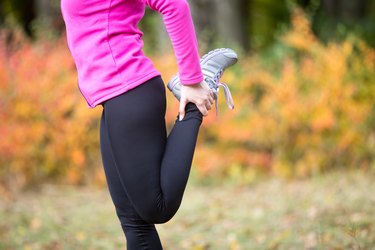
More than 54 million Americans have arthritis, according to the Centers for Disease Control and Prevention (CDC). That's more than 1 in 5 people. While there are some known risk factors that can lead to this common condition, many — such as a person's genes — are outside of our control.
But not all of them. "Some [forms of arthritis] are preventable, others are modifiable," says Daniel Wallace, MD, rheumatologist and spokesperson for Voltaren.
There are also many tactics that can help improve your overall joint health. That's important, since healthy joints allow you to move with ease and aid in protecting your bones, per the National Institute of Arthritis and Musculoskeletal and Skin Diseases (NIAMSD).
There Are 100+ Types of Arthritis
Arthritis refers to any type of pain or swelling in the joints, and there are more than 100 varieties, per Stuart D. Kaplan, MD, chief of rheumatology at Mount Sinai South Nassau in Oceanside, New York.
The most common type is osteoarthritis (OA), also known as degenerative arthritis, according to the Arthritis Foundation. As protective cartilage wears away, bones touch at joints — sometimes, you’ll hear OA referred to as wear-and-tear arthritis.
The other most commonly diagnosed variety is rheumatoid arthritis (RA), an inflammatory type. “It’s an auto-immune disease, which means the body is fighting itself. It can attack the joints, which become red-hot and swollen,” Dr. Kaplan says.
Some risk factors apply to only one of these two common forms.
Here are a few science-backed tactics that'll help reduce your arthritis risk factors, along with promoting good joint health.
1. Maintain a Healthy Weight

"Obesity is a big risk factor for osteoarthritis, especially in the weight-bearing areas, like the knees and lower back," Saad Tariq, MD, a rheumatologist with OrthoIllinois, tells LIVESTRONG.com.
The pressure on your knees adds up to 1.5 times your body weight, per Harvard Health Publishing — and that's on level ground; it's even higher on inclines (like steps) and can be up to five times your body weight when you squat to, say, tie your shoe.
That's why people with obesity are more likely to develop OA in these areas, per the CDC. And since excess fat leads to inflammation-causing proteins circulating in your body, obesity ups your risk of developing OA in your hands, too, per the Arthritis Foundation.
"Trying to modify the diet, and trying to exercise to lose weight can definitely prevent end-stage bone-on-bone arthritis [osteoarthritis] and chronic pain," Dr. Tariq says. (More on diet and exercise in a minute.)
Related Reading
2. Consider Following a Mediterranean Diet
There's no diet that can prevent arthritis (nor, for that matter, is there a diet that can cure this condition). That said, a healthy diet will help you manage your weight.
And there's one diet that might be particularly helpful to follow: "The Mediterranean diet has been shown consistently to be helpful for reducing inflammation," Dr. Tariq says. That's key, since both RA and OA involve inflammation in the joints.
Following the Mediterranean diet means eating lots of vegetables, fruits, fish, whole grains and healthy fats, while limiting red meat, according to the Mayo Clinic. It's linked to weight loss and a lower BMI, per a March 2019 review published in Nutrients.
The Mediterranean diet was helpful for managing symptoms in people with RA, but there wasn't enough evidence to support that the diet prevented RA in a December 2017 systematic review published in Rheumatology International.
But this diet may help to prevent RA in former and current smokers, according to a September 2020 study published in Arthritis & Rheumatology. And, while acknowledging some limitations in studies, an August 2018 review published in the journal Nutrients noted that OA prevalence is lower in people with high levels of adherence to the Mediterranean diet.
Don’t Forget About Fish
The Mediterranean diet encourages eating fish, which contain omega-3 fatty acids, per the National Institutes of Health. That may be helpful when it comes to preventing and treating RA. Consuming omega-3s regularly led to a decreased risk of developing RA, per a November 2014 study published in Annals of Rheumatic Disease. And a June 2020 study in the Mediterranean Journal of Rheumatology found that omega-3s may decrease disease activity in RA.
3. Eat Plenty of Fiber

Arthritis is an inflammatory disease — the symptoms of this condition spring from inflammation in the joints.
Consuming a high-fiber diet can decrease inflammation and improve osteoarthritis, Dr. Tariq says. Consuming higher fiber levels was associated with a lower risk of developing symptomatic OA in the knee, per a May 2017 study in Annals of the Rheumatic Diseases.
Fruits, vegetables, whole grains and legumes are all good sources of fiber, per the Mayo Clinic.
Tip
Women should get about 25 grams of fiber daily, while men should aim for about 38 grams, per the Academy of Nutrition and Dietetics.
It may also be helpful to limit or avoid inflammatory foods that can make symptoms worse. These include refined carbohydrates (think: white bread and pastries), fried foods, sugary beverages like soda, red and processed meats and margarine, according to Harvard Health Publishing.
4. Stop Smoking
It's hard to even tally up the reasons to quit smoking because this habit is so negative to nearly every facet of your health.
Smoking is a risk factor for developing RA, per the CDC.
It's a preventable risk factor for osteoarthritis, too, Dr. Tariq says, because smoking can lead to bone deterioration.
Related Reading
5. Brush Your Teeth

Practicing good dental hygiene — brushing several times a day, and flossing too — can help prevent gingivitis (gum disease), which may lead to RA, Dr. Tariq says.
Research certainly shows a link between gingivitis and RA. It's possible that inflammation associated with the teeth and mouth may "play a role in the development of rheumatoid arthritis," per a May 2013 review in Current Opinion Rheumatology. And more recently, a December 2016 study in Science Translation Medicine found that the bacteria involved in gingivitis also triggers the inflammatory response found in people with RA.
More research is needed here, though, as the Cleveland Clinic notes, to fully understand if one condition triggers the other one. Still, since gum disease isn't a desirable outcome either, it's a good idea to take care of your pearly whites.
6. Make Sure to Exercise
Along with helping you to maintain a healthy weight, exercise is also good for keeping muscles and joints healthy, Dr. Kaplan says.
"Any kind of exercise that doesn't strain muscles is good," he says, and cautions people to start gradually — especially if it's been a while since you've been active — and build up to a higher tolerance and endurance.
Tip
Aim for at least 150 minutes of moderate-intensity activity or 75 minutes of vigorous activity each week, per the Physical Activity Guidelines for Americans.
The stronger your muscles, the better they're able to protect your joints and potentially prevent osteoarthritis, per University of Iowa Health Care. Plus, physical activity helps prevent stiffness in your joints, according to the University of Rochester Medical Center.
"In general, I recommend range-of-motion exercises — things that keep the joints moving, like walking, swimming, bicycling," Dr. Kaplan says.
7. Prevent Joint Injuries

OA is mainly thought of as a disease that accompanies age — with a lot of use of the joint, cartilage wears down, leading to friction and the dreaded bone-on-bone contact.
But OA can also be the result of an injury caused by physical activity or accidents, per the Mayo Clinic.
Of course, you can't retreat to a bubble to avoid injuries and accidents. But there are reasonable and prudent tactics you can take to protect your joints:
Do Knee Exercises (Particularly if You Do Activities With a Risk of ACL Tears)
People who injure their anterior cruciate ligament (ACL) up their risk of having knee OA later in life by three to six times, per the Osteoarthritis Action Alliance (OAAA). But by doing neuromuscular training exercises proposed by the OAAA — which include balance training, plyometric jumping and core strengthening — you can cut the risk of an ACL or other knee injury by 80 percent.
That's worth considering if you play a sport — such as football or soccer — where ACL injuries are common.
Related Reading
Lift Right
We've all heard it: Lift with your legs, not your back. But the advice is solid to protect your back, Dr. Tariq says.
To lift objects correctly, per the American Chiropractic Association, follow these best practices:
- Keep objects close to your body
- Flex your elbows
- Have your head up and neck straight
- Lift with your legs, while having your spine straight (bending at the waist to lift engages your lower back muscles, and can lead to injuries)
Listen to your body, Dr. Tariq recommends — if something hurts, avoid doing it.
Tip
If your work involves lifting heavy objects, take particular care, Dr. Tariq says. Try to “regularly do back exercises and strengthen those muscles,” he says. Exercising the parts of the body that are frequently in use will prevent stiffness and pain.
Sit Better
Avoid the prolonged sitting (first in front of the computer, then later on the couch) that can take over a person's day, Dr. Tariq says. Why? Joint injuries are more common if you hold a position for a while, per the American Chiropractic Association.
"Every hour, try to get up and stretch and change your posture," Dr. Tariq recommends. Doing so will reduce pain and stiffness.
Take a look at your posture when you're sitting for long periods at your desk or during a long drive, he says. Having a neutral posture helps reduce aches and prevent pain.
Related Reading
Is this an emergency? If you are experiencing serious medical symptoms, please see the National Library of Medicine’s list of signs you need emergency medical attention or call 911.